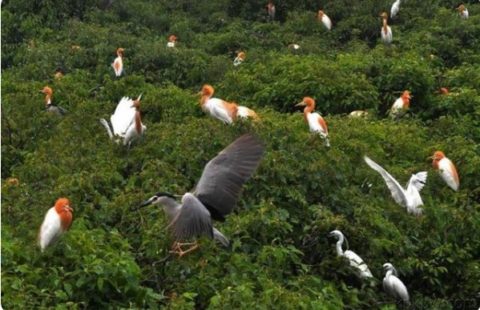
World Migratory Bird Day: Celebrating birds, wetlands and communities in China’s Liaohekou estuary
-
Species
World Migratory Bird Day (WMBD) is a global event celebrated twice every year, this year on 8 May and 9 October with the theme: Singing and Flying like a Bird. Working with the Liaohe Panjin Forestry and Wetlands Conservation and Management Bureau, and Panjin Forestry and Wetlands Conservation Service Centre in China, a Ramsar Site and East Asian – Australasian Flyway Network Site, we recently supported various awareness raising activities focussed around school children and local residents.
The survival of migratory birds is closely linked to our future. Our efforts to conserve and cherish migratory birds helps them complete their wondrous journeys to their breeding and non-breeding sites, as they migrate with the change of seasons. During their migrations back and forth, the birds require safe and productive stopover sites, especially wetlands to rest and fuel for their long journeys ahead. Unfortunately, migratory birds are facing great challenges along their flyways and are under multiple threats including land reclamation, aquaculture production, urbanisation and infrastructure development, as well as illegal killing.
Liaohekou estuary, based in the northern Bohai Sea of the Yellow Sea in Panjin, China, is a critical stopover site for shorebirds and other waterbirds during northern and southern migrations in the East Asian – Australasian Flyway (EAAF). Many species such as the Red-crowned Crane, Saunders’s Gull and Eurasian Oystercatcher also nest here. It is imperative to protect the Liaohekou wetlands for these migratory birds and the communities living there.
Four events recently took place in celebration of WMBD at the Liaohekou estuary, a demonstration site of the Flyway Bottleneck Yellow Sea project (FBYS), as part of a strong and collective effort to raise awareness and help protect vulnerable migratory birds and their habitats.
Celebrating WMBD with Xinglong primary and middle schools

On 7 May a programme entitled ‘Birds Singing’ was organised in Xinglong Primary School, where playing games, singing, and listening to bird calls sparked the children’s curiosity. While, on 10 May a programme entitled ‘Birds Flying’ was held in Xinglong Middle School involving paper cutting – a traditional handcraft. Using scissors and coloured paper, students cut out shapes of birds of their choice, usually ones they admired most. They expressed their commitment to learn basic knowledge of laws and regulations in place to protect birds and to engage in activities focused on conservation of migratory birds and their habitats.

In the morning of 8 May, a lecture on migratory birds was jointly organised by the Xinglong Elementary School and Panjin Forestry and Wetlands Conservation Service Centre. Their staff gave a presentation on birds to be found in the wetlands of the nature reserve. A 20-minute video on WMBD produced by Wetlands International was shown, that highlighted the crucial stopover role of Liaohe estuary for migratory shorebirds enroute from New Zealand and Australia, especially on their northward migration to the arctic breeding grounds. The video mentioned that shorebirds can migrate thousands of kilometres without stopping. The students were highly engaged, made notes and were happy to share what they learned – some even took to drawing the birds they love. One student said, “I love birds after learning about them, and I know what I can do for bird conservation during their migration.”
Students happily sung ”Where is Spring?”, which echoed around the classrooms and school. Through sessions like these more and more children are aware about wetlands, migratory birds, and their value, and witness the harmonious relationship between nature and people. The students became big fans of migratory birds.

Fostering public awareness with partners and organizations
In the morning of 9 May, Panjin Forestry and Wetlands Conservation Service Centre staff and volunteers visited the Dingxiang Birds Garden to raise public awareness of migratory birds, wetlands and promote an understanding of why their conservation is important. Ten poster boards were set up to present information on migratory birds, flyways, Liaohe wetlands, updated illustrated lists of the national protected wildlife, and key migratory birds that can be seen in the coastal wetlands in Panjin City. Staff and volunteers circulated leaflets and showed visitors around the garden, watching birds and teaching them how to distinguish birds calls.


The local Panjin Saunders’s Gull Conservation Association asked its members and the public to produce videos with the key words – “Listening to birds singing”. Collectively, videos worth nearly 1000 minutes were gathered from citizens. Some videos were produced by children and their parents. Other videos circulated on media platforms such as Tik Tok, Wechat and Quick Worker to help celebrate WMBD 2021.
Through these annual awareness raising events, Panjin Forestry and Wetlands Conservation and Management Bureau Panjin and Wetlands International aim to continue to enhance local support for management and restoration of critically important wetlands and ensure conservation of migratory waterbirds and wetlands in the Yellow Sea and East Asian – Australasian Flyway.
